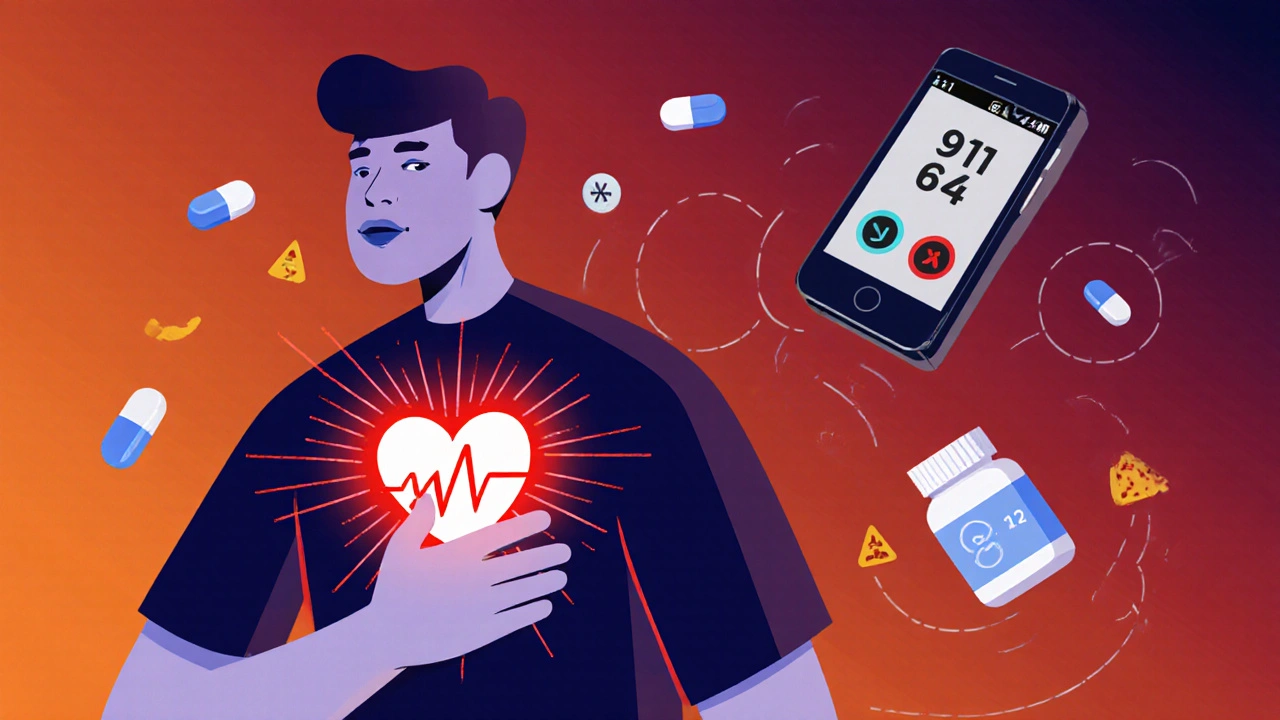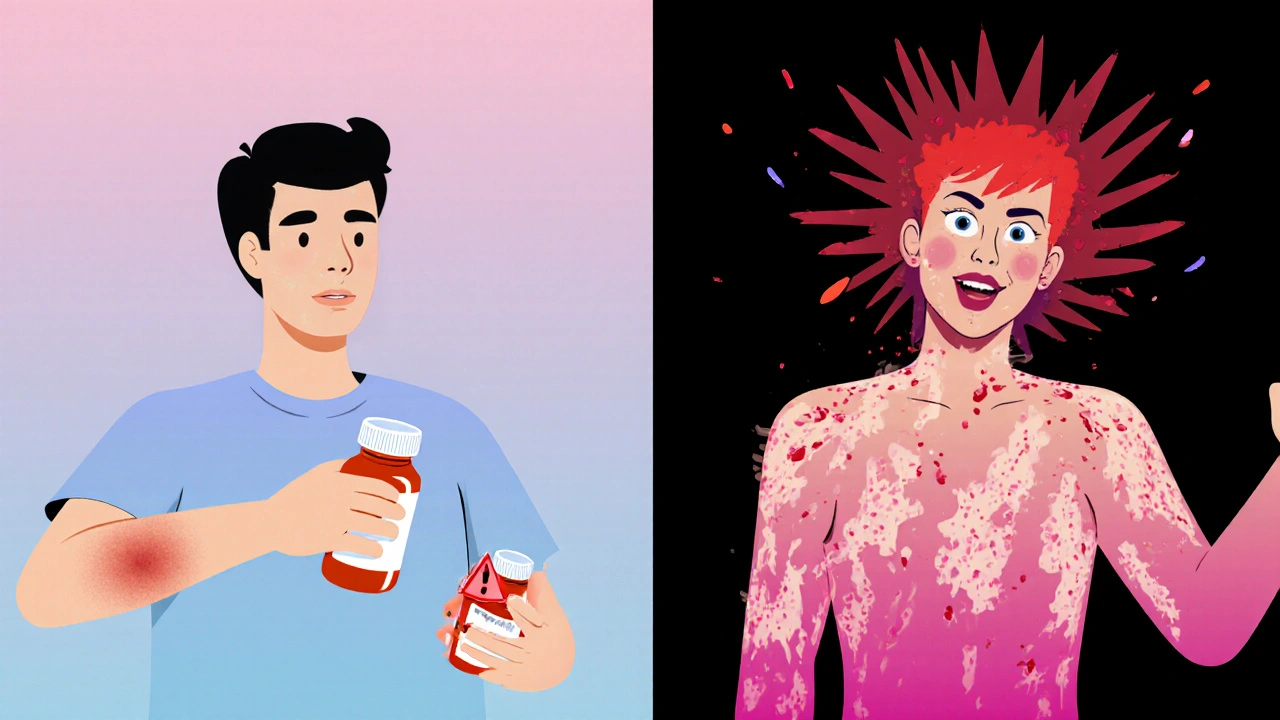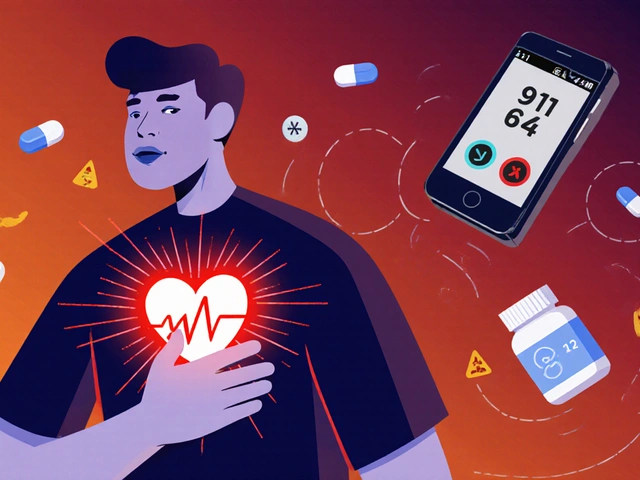When to Seek Emergency Care for Medication Side Effects: Red Flags You Can't Ignore

Medication Emergency Checker
Is This a Medical Emergency?
This tool helps you determine if your symptoms require immediate emergency care based on FDA guidelines. If you experience any red flag symptoms, call 911 immediately.
Select all symptoms that apply to determine if you need emergency care.
Results will appear here after checking your symptoms.
Every year, over 106,000 people in the U.S. die from adverse reactions to medications. Many of these deaths happen because symptoms were ignored, misread, or dismissed as "just a side effect." You’re not alone if you’ve ever wondered: Is this normal, or is this an emergency? The difference between waiting a few hours and calling 911 can mean the difference between life and death.
What Counts as a Medication Emergency?
Not every side effect needs an ER visit. Nausea after antibiotics? That’s common. But if that nausea turns into vomiting so severe you can’t keep fluids down, or you start feeling dizzy and your heart races - now you’re in danger. Medication emergencies aren’t about how many pills you took. They’re about how your body is reacting.The FDA defines a serious adverse drug reaction as one that causes death, life-threatening conditions, hospitalization, disability, or birth defects. These aren’t rare. In fact, drug reactions are the fourth leading cause of death in the U.S. The key is recognizing the red flags before it’s too late.
Life-Threatening Symptoms That Demand Immediate Action
There are specific signs that mean you need to call 911 right now, not wait for your doctor’s office to open. These aren’t vague warnings - they’re measurable, urgent red flags:- Difficulty breathing or wheezing - Especially if your lips or tongue swell up. This isn’t just an allergy - it’s anaphylaxis, and it kills within minutes without epinephrine.
- Blue or gray lips, tongue, or skin - This means your body isn’t getting enough oxygen. Cyanosis is a late sign, and by the time you see it, you’re already in crisis.
- Heart rate below 50 or above 110 beats per minute - Especially if you’re dizzy, fainting, or chest pain is present. Your heart can’t sustain this for long.
- Blood pressure above 180/120 with headache, slurred speech, or weakness on one side - This isn’t just high blood pressure. It’s a hypertensive emergency that can cause stroke or brain bleed.
- Pulse oximeter reading below 94% on room air - If you’re not on oxygen and your blood oxygen drops this low, your organs are starving.
- Temperature of 102°F or higher - Especially if you’re on immunosuppressants, antibiotics, or chemotherapy. Fever can mean your body is fighting a dangerous reaction.
These aren’t "maybe" symptoms. They’re clear signals your body is shutting down. If you’re taking any medication and you experience even one of these, don’t call your pharmacy. Don’t wait for a telehealth appointment. Call 911.
Allergic Reactions: The Silent Killer
Most people think of allergies as sneezing or itchy eyes. But drug allergies can be deadly. Penicillin, sulfa drugs, insulin, and certain antibiotics are the most common triggers. The problem? Many patients don’t realize they’re allergic until it’s too late.Anaphylaxis doesn’t always start with a rash. Sometimes it starts with a feeling of warmth, a metallic taste in your mouth, or tightness in your throat - then comes swelling, vomiting, and collapse. A 2022 study found that 35% of anaphylaxis cases are initially mistaken for asthma or panic attacks. That delay costs lives.
If you’ve been prescribed an epinephrine auto-injector (like an EpiPen), carry it with you at all times. Use it the moment you feel any of the symptoms above. Then call 911. Epinephrine saves lives - but it’s not a cure. You still need emergency care.
Severe Skin Reactions: Stevens-Johnson Syndrome and Toxic Epidermal Necrolysis
You might think a rash is just a rash. But some drug rashes are a sign your skin is literally detaching from your body. Stevens-Johnson Syndrome (SJS) and Toxic Epidermal Necrolysis (TEN) are rare but deadly. They often start with flu-like symptoms - fever, sore throat, burning eyes - then progress to painful blisters and peeling skin.These reactions are most commonly caused by antibiotics (like sulfonamides), antiseizure drugs (like carbamazepine), and painkillers like NSAIDs. The mortality rate for TEN can exceed 30%. If you notice:
- Widespread red or purple rash that spreads quickly
- Blisters on your mouth, eyes, or genitals
- Painful skin that peels off in sheets
- go to the ER immediately. This is not a dermatologist appointment. This is a burn unit emergency.

Drug Interactions: The Hidden Danger
You’re not just taking one medication. You’re likely taking several - maybe blood pressure pills, a statin, a painkiller, and a supplement like St. John’s Wort. The more drugs you take, the higher your risk.Over 15,000 drug interactions are documented. About 700 of them can cause life-threatening reactions. Here are two real examples:
- Warfarin + ibuprofen - This combo increases your risk of internal bleeding by 50%. Even a minor fall can become fatal.
- Antibiotics like ciprofloxacin + blood thinners - These can spike your INR (a measure of blood clotting) within 24-48 hours. You could bleed internally without warning.
People on five or more medications have a 300% higher risk of severe reactions than those on just one. If you’ve recently added a new drug - even an over-the-counter one - pay attention. Symptoms that appear within 72 hours of a dosage change are the most dangerous. According to the FDA, 68% of serious reactions happen in that window.
What’s Not an Emergency - But Still Needs Attention
Not every weird feeling means you’re dying. Some side effects are annoying but not dangerous:- Mild nausea or upset stomach (common with antibiotics or chemo)
- Headache after starting a new blood pressure med (often resolves in a few days)
- Dry mouth from antihistamines or antidepressants
- Insomnia from stimulants or decongestants
These aren’t emergencies - but they’re still worth reporting. If a side effect lasts more than a few days, gets worse, or starts interfering with your daily life, call your doctor. Don’t just stop the medication. That can be dangerous too.
Why People Wait Too Long - And What Happens When They Do
A Mayo Clinic survey found that 61% of patients didn’t know when their medication side effects required emergency care. Reddit threads are full of stories like this: "I had swelling and a rash after amoxicillin. Thought it was just an itch. Waited four hours. Then I couldn’t breathe. That’s when I called 911."Delayed care is the norm, not the exception. Why? Because:
- Doctors don’t always explain what to watch for.
- Labels on pill bottles don’t say "call 911 if you feel X."
- People think they’re overreacting.
Only 42% of patients get clear instructions on when to seek emergency care. That’s a failure of the system - not the patient.
What to Do Before You Need an Emergency
You can protect yourself. Here’s how:- Keep a current list of every medication - including vitamins, supplements, and herbal products. St. John’s Wort interacts with over 50 drugs. Most people don’t realize it’s a medication.
- Ask your pharmacist - When you pick up a new prescription, ask: "What are the warning signs I should never ignore?"
- Know your high-risk meds - Blood thinners, insulin, seizure drugs, chemotherapy, and antidepressants carry the highest risk. Know your specific dangers.
- Set phone reminders - If you start a new drug, set a reminder for day 3. Ask yourself: "Have I felt any new, strange symptoms?"
- Wear a medical alert bracelet - Especially if you have a known drug allergy or take anticoagulants.
What Happens in the ER?
When you arrive with suspected medication toxicity, they’ll check your vital signs, run blood tests (like liver enzymes, kidney function, INR), and look for signs of organ damage. They may give you activated charcoal to absorb the drug, IV fluids, or antidotes like naloxone for opioid overdoses or flumazenil for benzodiazepine reactions.They’ll also review your entire medication list - including what you didn’t tell them. Many patients forget about supplements or over-the-counter drugs. That’s why having a list matters.
The goal isn’t just to treat the reaction. It’s to figure out what caused it - so it doesn’t happen again.
Final Thought: Trust Your Body
You know your body better than any algorithm or pamphlet. If something feels wrong - really wrong - don’t second-guess yourself. If you’re thinking, "Should I go?" - the answer is yes.Medication emergencies don’t always come with sirens. Sometimes they come as a whisper: a strange fatigue, a tingling in your fingers, a sudden headache. Listen. Act. Save a life - maybe your own.
Can I wait until morning if I have a mild rash from a new medication?
Only if the rash is isolated, not spreading, and you have no other symptoms like swelling, trouble breathing, fever, or pain. If the rash is spreading, painful, or you feel unwell in any way, go to the ER. Some rashes that start mild can turn deadly within hours.
Do I need to stop taking my medication if I have side effects?
Never stop a medication without talking to your doctor. Stopping suddenly can cause withdrawal, rebound effects, or worsen your condition. For example, stopping blood pressure meds abruptly can cause a dangerous spike in pressure. Call your prescriber first - unless you’re having an emergency symptom like trouble breathing or chest pain.
Are herbal supplements safe to take with prescription drugs?
No. Supplements like St. John’s Wort, garlic, ginkgo, and kava can interact dangerously with blood thinners, antidepressants, and heart medications. They’re not regulated like prescription drugs, so their strength and ingredients vary. Always tell your doctor and pharmacist exactly what you’re taking - even if you think it’s "natural."
Can I use an online symptom checker instead of going to the ER?
Online tools can help you decide whether to call your doctor - but they cannot replace emergency care. If you have symptoms like difficulty breathing, blue lips, slurred speech, or sudden weakness, call 911 immediately. Algorithms don’t save lives in real time. People do - with epinephrine, oxygen, and IV fluids.
How do I know if my reaction is from a new drug or something else?
Timing matters. If your symptoms started within 72 hours of starting a new medication, changing a dose, or adding a supplement, it’s likely related. But reactions can also be delayed - some show up after weeks. Keep a symptom diary: write down what you took, when, and how you felt. This helps doctors connect the dots.


Jacob McConaghy
Just had my mom almost die because she thought her rash from amoxicillin was 'just an itch.' Four hours later, her tongue was swelling and she couldn't breathe. EpiPen saved her, but we were seconds away from losing her. If you're even a little unsure - call 911. No one ever regrets acting fast.
Natashia Luu
It is profoundly concerning that the general populace continues to misinterpret life-threatening physiological responses as benign dermatological anomalies. The absence of standardized, mandatory patient education protocols regarding adverse drug reactions constitutes a systemic failure of medical ethics and public health infrastructure.
akhilesh jha
In India, we don’t have easy access to ERs or EpiPens. My cousin took an antibiotic and got a rash. He waited two days because he thought it was heat. By the time he got to a hospital, his skin was peeling. They told us it was TEN. He survived, but lost 40% of his skin. This isn’t just an American problem. People everywhere need to know this.
Jeff Hicken
bro i took ibuprofen with my blood thinner once and i thought i was gonna die. like, my chest felt like it was being squeezed by a bear. called 911. turned out my inr was 8.5. they pumped me full of vitamin k. i still take it now but i never skip my blood tests again. ps. dont trust those online symptom checkers. they think everything is a panic attack.
Vineeta Puri
It is imperative that healthcare providers prioritize clear, written, and verbal communication regarding potential adverse reactions. Patients often rely on implicit cues and may not recognize the gravity of symptoms without explicit guidance. A simple handout or verbal checklist during prescription dispensing can prevent unnecessary tragedies.
Victoria Stanley
I’m a nurse and I can’t tell you how many times I’ve seen people wait because they ‘didn’t want to bother anyone.’ You’re not bothering us. You’re saving your life. If you’re thinking ‘maybe I should go,’ you already know the answer. Bring your meds list. Write down when symptoms started. It helps us help you faster.
Andy Louis-Charles
Just a heads up 🚨 - if you’re on statins and start feeling muscle pain or dark urine, go to the ER. Rhabdo is real. I had a friend who thought it was just sore from the gym. Ended up in ICU for 3 weeks. Don’t be that guy. Know your meds.
Douglas cardoza
my grandma died from this. took a new blood pressure med, got dizzy, thought it was just old age. fell, cracked her skull. they said the med dropped her bp too fast. she didn’t even know it was a risk. why don’t they just print this stuff on the bottle???
Adam Hainsfurther
I’ve been on 7 meds for years. I keep a spreadsheet: drug, dose, start date, side effects. I update it every time I get a new script. My pharmacist says it’s the most organized list he’s ever seen. If you’re on more than 3 meds, do this. It’s not extra work - it’s survival.
Rachael Gallagher
Big Pharma doesn’t want you to know how dangerous these pills are. They make billions while you bleed out in your living room. The system is rigged. Don’t trust your doctor. Trust your gut. And get off everything you can.
steven patiño palacio
One of the most overlooked facts: over 50% of serious drug reactions occur within the first 72 hours of starting a new medication. That’s why I set a reminder on my phone for every new prescription - Day 1, Day 2, Day 3. I ask myself: ‘Is anything new? Is anything worse?’ It’s a habit that has saved me from three near-misses.
stephanie Hill
They say ‘trust your body’ - but what if your body’s been programmed to ignore pain? What if the system taught you that suffering is normal? I used to take 10 ibuprofen a day for ‘just a headache.’ Now I know it was slowly killing my kidneys. They don’t warn you. They just keep prescribing. This isn’t medicine. It’s a slow-motion trap.